Related Research Articles
Vermes ("worms") is an obsolete taxon used by Carl Linnaeus and Jean-Baptiste Lamarck for non-arthropod invertebrate animals.

Linda Maria Ronstadt is a retired American singer who performed and recorded in diverse genres including rock, country, light opera, and Latin. She has earned 11 Grammy Awards, three American Music Awards, two Academy of Country Music awards, an Emmy Award, and an ALMA Award. Many of her albums have been certified gold, platinum or multiplatinum in the United States and internationally. She has also earned nominations for a Tony Award and a Golden Globe award. She was awarded the Latin Grammy Lifetime Achievement Award by the Latin Recording Academy in 2011 and also awarded the Grammy Lifetime Achievement Award by the Recording Academy in 2016. She was inducted into the Rock and Roll Hall of Fame in April 2014. On July 28, 2014, she was awarded the National Medal of Arts and Humanities. In 2019, she received a star jointly with Dolly Parton and Emmylou Harris on the Hollywood Walk of Fame for their work as the group Trio. Ronstadt was among five honorees who received the 2019 Kennedy Center Honors for lifetime artistic achievements.

Linda Louise McCartney, Lady McCartney was an American photographer, musician, animal rights activist, and entrepreneur. She was best known as the first wife of English musician Paul McCartney and for her photographs of celebrities and contemporary musicians. Her photos were published in the 1992 book Linda McCartney's Sixties: Portrait of an Era.

George Montagu was an English army officer and naturalist. He was known for his pioneering Ornithological Dictionary of 1802, which for the first time accurately defined the status of Britain's birds. He is remembered today for species such as the Montagu's harrier, named for him.

Rhagonycha is a genus of soldier beetle belonging to the family Cantharidae. There are at least 140 described species recorded from Europe, North America and Japan, and thought to date from the Upper Eocene to recent periods.

Giuseppe Saverio Poli was an Italian physicist, biologist and natural historian.
Sphecosoma is a genus of moths in the subfamily Arctiinae. The genus was erected by Arthur Gardiner Butler in 1876.
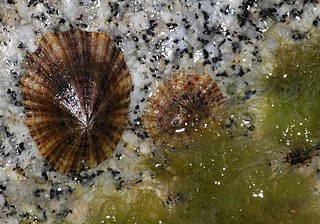
Patella caerulea, is a species of limpet in the family Patellidae. It is known by the common names Mediterranean limpet and rayed Mediterranean limpet. It is native to the Mediterranean Sea.
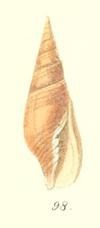
Strigatella testacea is a species of sea snail, a marine gastropod mollusk in the family Mitridae, the miters or miter snails.
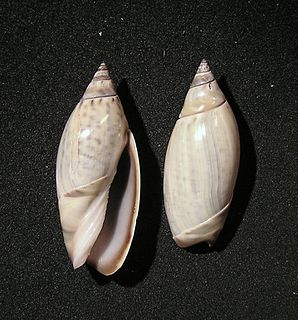
Agaronia testacea, common name the Panama false olive, is a species of sea snail, a marine gastropod mollusk in the family Olividae, the olives.

Anaesthetis testacea is a species of longhorn beetle. It is a common species in Europe that develops in the dead, terminal twigs of deciduous trees and shrubs.
Neacerea testacea is a moth of the subfamily Arctiinae. It was described by Herbert Druce in 1884. It is found in Guatemala, Panama and Honduras.

Linda is a genus of longhorn beetles of the subfamily Lamiinae, containing the following species:
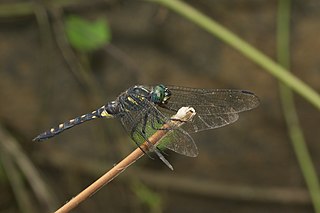
Onychothemis testacea, Stellate river hawk, riverhawker, is a species of dragonfly in the family Libellulidae. It is widespread in many Asian countries.
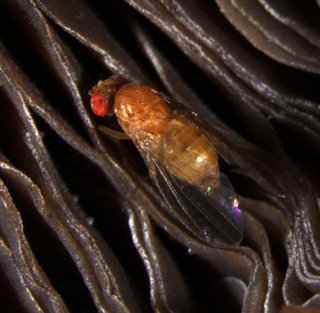
Drosophila neotestacea is a member of the testacea species group of Drosophila. Testacea species are specialist fruit flies that breed on the fruiting bodies of mushrooms. These flies will choose to breed on psychoactive mushrooms such as the Fly Agaric Amanita muscaria. Drosophila neotestacea can be found in temperate regions of North America, ranging from the north eastern United States to western Canada.

Drosophila testacea is a member of the testacea species group of Drosophila. Testacea species are specialist fruit flies that breed on the fruiting bodies of mushrooms. Drosophila testacea can be found in temperate regions of Europe, extending to east Asia. Drosophila testacea and Drosophila orientacea can produce viable hybrids, though they are separated by geography and behavioural barriers. Drosophila testacea females will also readily mate with Drosophila neotestacea males, but viable hybrids are never produced. This hybrid inviability ) may be due to selfish X chromosomes and co-evolved suppressors. Alternately, differences in sex pheromone reception could underlie female readiness and male willingness to copulate.
Drosophila orientacea is a member of the testacea species group of Drosophila. Testacea species are specialist fruit flies that breed on the fruiting bodies of mushrooms. Drosophila orientacea is found in northern Japan on the island of Hokkaido. However, the European species Drosophila testacea and D. orientacea can produce viable hybrids, blurring the level of speciation between the two species. While viable hybrids are produced, extreme behavioural barriers likely prevent mating in the wild. While D. orientacea readily mates with Drosophila neotestacea, viable hybrids are never produced. This hybrid inviability may be due either to issues during copulation, or selfish X chromosomes and co-evolved suppressors.
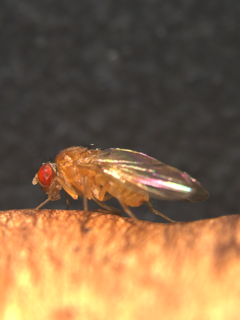
The Drosophila testacea species group belongs to the Immigrans-tripunctata radiation of the subgenus Drosophila, and contains 4 species: Drosophila putrida, Drosophila neotestacea, Drosophila testacea, and Drosophila orientacea. Testacea species are specialist mushroom-feeding flies, and can metabolize toxic compounds in Amanita mushrooms. The Testacea species group is studied for its specialist ecology, population genetics, and bacterial endosymbionts. The North American species Drosophila neotestacea is perhaps the best-studied of the group for its interactions with parasitic wasps and nematodes, bacterial endosymbionts, and trypanosomatid parasites. Of note, selfish X chromosomes have been discovered in three of the four Testacea group species.

Mushroom-feeding Drosophila are a subset of Drosophila flies that have highly specific mushroom-breeding ecologies. Often these flies can tolerate toxic compounds from Amanita mushrooms.
References
- ↑ BioLib.cz - Linda testacea. Retrieved on 8 September 2014.